|
|
On Monday the gray wolf was removed from the Endangered Species Act (ESA) in Idaho and Montana, two states that have protected the wolf for decades. According to the federal government the decision to remove those wolf populations was based on sound conservation science—a fact greatly disputed in conservation circles. For unlike the bald eagle, whose population is still rising after being delisted in 1995, when the wolf is removed from the ESA it will face guns blazing and an inevitable decline.
Secretary of the Interior, Ken Salazar decided to delist the wolves in March after meeting with scientists from the Fish and Wildlife Service. This followed a decision in January 2008, when former President George W. Bush decided to take the gray wolf off the ESA in the Rockies, namely Idaho, Montana, and Wyoming. The removal angered conservation organizations, who argued that wolf populations were not yet large enough to sustain the hunt that would follow. Subsequent months proved them right.
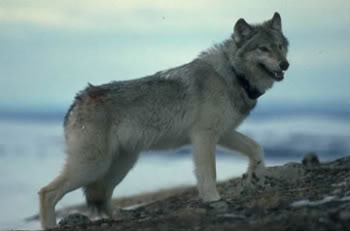 Canis lupus or the gray wolf. Photo courtesy of the USGS. |
Removed in March of 2008, wolf hunting commenced in Wyoming until July—five months later—when a judge agreed with environmentalists and placed an immediate halt to the hunts. In those five months Wyoming lost at least a quarter of its wolves. One hundred individual wolves were shot and killed out of an estimated population of 300-400. If the hunt had been allowed to continue Wyoming’s wolves would have become nearly exterminated or placed back on the ESA. The wolf hunting season had not yet begun in Montana or Idaho, before the judge shut it down.
Perhaps learning from the situation in Wyoming, Salazar decided to keep wolves on the ESA in that state alone. He cited that the state had not yet provided a convincing management program for wolf populations: Wyoming’s plan, or lack thereof, would have allowed wolves to be killed by anyone at anytime without a license in most of the state.
While Salazar states that his decision is based entirely on science—and I believe him and commend such a change from the Bush Administration—the problem is that the science is shortsighted and rooted in conservation ideas that are making their way out the door due to the fact that they are not proving effective in sustaining healthy, long-term populations of species in trouble—especially of large predators like the wolf.
The de-listing of wolves from the ESA is too soon and will unravel decades of work, wasting countless hours of work and the 27 million dollars spent on reintroducing wolves into lost habitat.
Flaws in science
Currently, there are approximately 1,600 wolves in the Rocky Mountain region. Conservation groups, which are suing the federal government, argue that 2,000-2,500 wolves are required in region for long-term viability. While the question before the court will be: has the Fish and Wildlife Service and the Department of the Interior made a convincing argument that this a sustainable population? A further caveat will undoubtedly be close to everyone’s mind: is this population large enough to thrive under targeted hunting? It’s one thing to no longer work strenuously to aid an endangered species, another altogether to allow hunting.
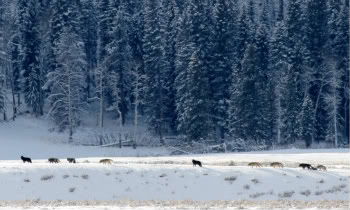 Wolf pack moves through snowy landscape in Yellowstone National Park. Photo by: Thomas Christie. |
Human hunters don’t choose to target weak or sick animals; instead they shoot what they find, which could just as easily be an alpha male or female as an old sickly individual. The loss of a genetically viable healthy adult can be massive, especially when populations of wolves are as small and fractured as they are in the continental US.
Another concern is that the population becomes so small and isolated that they eventually suffer from genetic disorders due to interbreeding. The Fish and Wildlife Service has argued that wolf populations in the Rockies are not threatened by such problems—even down the road. However, a recent study from Michigan’s Isle Royale cuts holes in this argument. The study found that the wolf population of Isle Royale, cut off from all other wolves, has suffered severe bone deformities due to interbreeding.
Certainly the population of Isle Royale wolves is small—up to 50—but it represents what happens to wolves when forced to survive in an island habitat, a situation not dissimilar from what may happen to wolves in the west if they are allowed to be hunted into ever-smaller islands of habitat, such as national parks and other protected areas. When all of Wyoming has only 300 wolves, the genetic findings of wolves in Isle Royale is a warning call.
Another large predator in the Rockies provides an additional lesson. Grizzly bears lost their ESA status in 2007, and already researchers have begun warning that bears—who spent decades, like wolves, on conservation- triage—are in danger of losing all of their population gains after a few years. Researchers are blaming the bears’ decline on hunting and global warming. The Yellowstone National Park region encompassing Wyoming, Idaho, and Montana included a total of 600 grizzly bears when they lost their status. But the region lost 71 bears just this past year, 48 of which were killed by hunters. In addition, a warmer Rockies has allowed bark beetles to destroy whitebark pine trees, a species whose seeds bears depend on for food. The fact that bears may already require being listed again on the ESA highlights just how much time and money is wasted when a species is delisted prematurely or mismanaged once taken off the ESA.
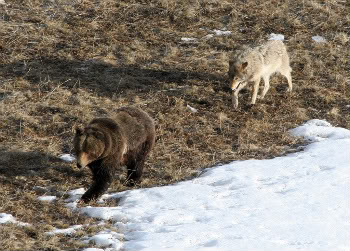 Two rare predators roam the continental US again: a gray wolf shadowing a grizzly. Photo courtesy of the National Park Service. |
Some proponents of wolf hunting point to a study in Alaska which claims that wolves can suffer a 20-40 percent mortality rate by humans annually and still recover their numbers. However, even if these somewhat remarkable statistics are correct, one should remember Alaska is an altogether different world when it comes to wolves; habitat is large and unbroken and wolves have never suffered a decline similar to the continental US. The population there is strong, viable, and has not required reintroduction efforts into a fractured habitat, split by roads, cities, ranches, and barbed wire.
Conservationists state that neither Montana’s or Idaho’s management plans are legally bound to maintain 150 wolves and 15 breeding pairs—numbers which the Fish and Wildlife Services have deemed necessary for survival.
The wolf’s ‘shifting baseline’
Both sides of the battle are ignoring some vital new ideas regarding conservation, such as the theory of ‘shifting baselines’. This theory, first developed by marine biologist David Pauly, questions our view of the natural world, stating that due to short life-spans humans have a poor conception of how much of the natural world has been degraded by our actions, because our ‘baseline’ shifts with every generation. In essence, what we see as pristine nature would be seen by our ancestors as hopelessly degraded, and what we see as degraded our children will see as ‘natural’.
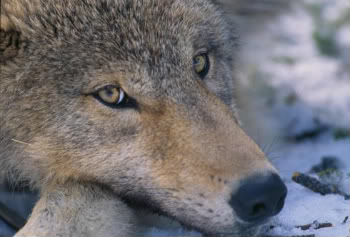 Close-up of wolf pup. Photo courtesy of the National Park Service. |
This theory is certainly being played out in regards to the wolf: our government scientists, intelligent and capable men and women, believe that 1,600 wolves in the Rockies is ‘enough’ and 150 wolves in Montana and the same in Idaho is somehow sufficient. But historic numbers make the current number of wolves in the continental US—5,000 in total—look pathetic. Genetic evidence shows that there were likely more than 200,000 wolves in the continental US when Europeans arrived. While the current population may be enough for wolves to slog along for a few decades, it can hardly be claimed as ‘recovery’. In fact even after decades of reintroduction wolves can only be found in 5 percent of their original habitat in the continental US. While gray wolves used to be found in nearly every state—except the Southeast where their population ran up against the red wolf (which is critically-endangered, just barely surviving on a few islands)—they are now found in only seven and have become delisted just as they are making their way—on their own—to new regions.
Globally there are an estimated 20,000 wolves. While this may sound like a sizeable number it is one percent of the wolf’s historic population, which is estimated at 2 million individuals. This means that even when wolves are considered largely ‘recovered’ globally their population has still fallen 99 percent. If human population fell so precipitously, the whole world would be emptied of our species except for those in France.
Now, I am not arguing for wolf populations to reach 200,000 in the continental US or 2 million worldwide. Obviously, not enough habitat remains anymore to sustain anywhere near such abundance, but the US can certainly handle more than a few thousand and states like Idaho and Montana surely have the wilderness to support more than a paltry 150 wolves.
To remove the wolf when it has barely recovered, when it is just starting to expand its range into states like Washington, when it still hasn’t found its way into the Southwest Rockies and the Northeast, is folly. Especially when it means that states will begin wolf hunting: undoing all that has been done.
The modern wolf hunt
Wolf hunting is an aberration in this day and age. Wolves are imperative to a complete ecosystem: they keep populations of large herbivores in check and healthy, such as deer, elk, and moose. Their importance is quite clear in the past century after they were nearly wiped out of the lower 48 states, along with most other large predators, and deer populations exploded. While wolves have returned in a few places, their predatory skills are lacking in many others.
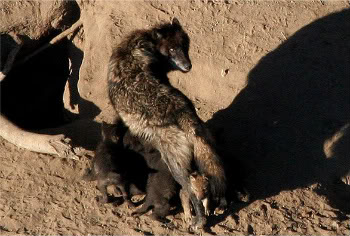 Wolf nursing her young. Photo courtesy of the National Park Service. |
I am not a hunter myself, but I respect all that hunters have done for conservation in this country. However I think most hunters would agree that an ecosystem made up simply of ‘game’ animals, i.e. deer and elk, and man with a gun is not a true ecosystem.
As a sport wolf hunting is meaningless. You can’t eat them. There is little to no market for their fur. Even the ‘sport’ of killing wolves is undercut. What chance do these animals have when facing guns and even helicopters? They are ‘trophy’ animals, killed for the thrill of killing, nothing else, dying for the arguably twisted and brief joy a shooter feels at taking their life: an anachronistic hobby at best.
Some throw down the argument of yore: wolves are nuisance animals that have no place near ranches and farms. Time and again this characterization of wolves has been proven wrong. In 2005 cattle killed by wolves represented 0.1 percent. Dogs killed five times as many cattle that year. I sympathize with ranchers and believe it is imperative for government programs to provide compensation if a wolf kills a cow. And if an individual wolf becomes a ‘nuisance’ then the issue should be revert to the Fish and Wildlife Department to consider the best option, i.e. moving the wolf or putting it down.
But killing wolves for sport is a moral problem worthy of consideration. If someone were found to be shooting dogs in Idaho or Montana, they would be arrested and charged according to the state’s animal cruelty laws. However, dogs are domesticated wolves and in terms of what may be termed ‘intelligence’ and ‘social cognition’ the animals are indistinguishable. Wolves are highly intelligent animals with deep emotional lives and complex social relations with their fellows. Therefore a law which protects dogs but allows wolves to be hunted for sport is starkly hypocritical.
What kind of nature?
For citizens not involved in the legality of the wolf hunt, the question perhaps is best put this way: what kind of nature do we want? Do we as Americans value viable healthy ecosystems with wild animals? Do we actual prefer our wilderness to be ‘wild’ or are we fine with stunted, broken wilderness areas, lacking in functioning ecosystems, basically a game park for hunters or a nice little walk for hikers, but nothing true about it.
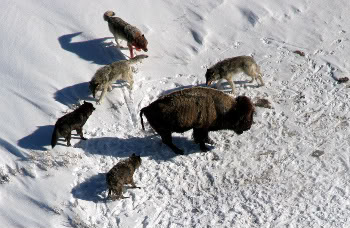 Wolves surround bison in Yellowstone National Park. Photo courtesy of the National Park Service. |
As it is wolves exist in a zoo-like state. They are now protected in only small constricted habitats, like Yellowstone National Park, and even there they have become essentially a symbol of everything the country has lost rather than what it has gained. While wolves are said to ‘move freely’, in fact, their movement is greatly stunted by the multitude of blockades in man-made civilization. They are boxed-in and caged.
Americans like to think of themselves as protectors of a beautiful wilderness, inhabiting a bold and varied landscape from sea to shining sea. Many of our nation’s mythos, from Jack London to James Fenimore Cooper to Henry David Thoreau, are developed around wilderness. However we rarely live up to what we proclaim. The best wilderness in North America is not in Wyoming or Arizona or California, it’s everywhere else: Canada, Mexico, and Alaska (truly our last frontier). America’s wilderness is represented largely by our National Parks. But recent research has shown they are simply too small to protect ecosystems, watersheds and species. In fact, visiting a popular National Park usually means seeing more cars and people than animals.
What kind of nature do we want? Should we hand our children the landscapes exalted and beloved by our ancestors or will strip malls and housing developments be all we leave behind?
Does nature require large predators like wolves and bears roaming freely, or are we happy with increasingly zoo-like National Parks where the collision between predator and prey is as non-existent as when lions are separated from zebra by a fence?
Time better spent
The back-and-forth lawsuits which are set to begin again soon—conservation organizations suing the federal government from one side, while Wyoming, bitter about its wolf plan being denied, sues from the other end—is, to be frank, a waste of time and energy when there are bigger issues to tackle. Wolfs have been on the path to recovery; while many other species in the United States are greatly threatened without any protection, lingering for years while the ESA fails to make up its mind. It would be better if the Fish and Wildlife Service, along with conservation groups, could focus on these desperate species.
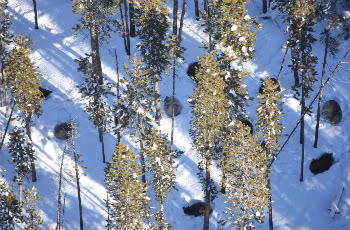 Wolves bedding down for the night. Photo courtesy of the National Park Service. |
The Fish and Wildlife Service could have saved themselves a lot of trouble by simply admitting the wolf population still needed time to recover and re-colonize before becoming ‘in season’, a reasonable and forward-looking statement backed up by many researchers and studies. Or they could have gone forward with delisting the wolf but adding provision that forbid hunting—this is what the Midwest has done where delisted wolves are classified as non-game animals. Instead the Interior Department has needlessly threatened its own work, and whether a judge or the agency itself places the wolves back under the ESA’s protection in a few years, it will happen. It’s only a matter of time.
While I applaud Ken Salazar for stating that his decision to delist wolves was based on science alone and not politics, the real problem is that Salazar’s decision was based on old curmudgeony science, a conservation science that basically attempts to throw endangered species off the list as quickly as possible, rather than fulfilling a full recovery. Conservation should, in fact, must be forward-looking if we are to avoid the mass extinction threatening species across the world. We must begin thinking in terms of abundance rather than simple existence, especially for species that were historically abundant—until persecuted by humans through guns and poison.
So, let’s put the wolf question behind us for now by granting them protection again, and deal instead with polar bears, pikas, cave spiders, Chucky madtoms, Streaked horned lark, jaguars, Sisi snails, sand dune lizards, wolverines, Kauai creepers, and countless other species that deserve consideration from our federal government.
Related articles
When in season, wolves choose salmon over deer
(09/02/2008)
The popular image of hunting wolves is a pack bearing down on a deer, working in concert to make the kill. However, new research has discovered that when available, wolves largely forgo hoofed mammals for salmon.
First wolves killed in Wyoming after species loses ESA protection
(04/02/2008)
In one of a series of controversial decisions regarding the Endangered Species Act recently, the federal government has dropped the Rocky Mountain grey wolf from the program. The announcement of the de-listing was made in mid-February, but did not go into effect until Friday when the reins of control were handed over from the federal government to the individual states. Over the weekend wolf-hunting began in Wyoming.
Fewer wolves may mean fewer pronghorn in Yellowstone
(03/03/2008) As western states debate removing the gray wolf from protection under the Endangered Species Act, a new study by the Wildlife Conservation Society cautions that doing so may result in an unintended decline in another species: the pronghorn, a uniquely North American animal that resembles an African antelope.